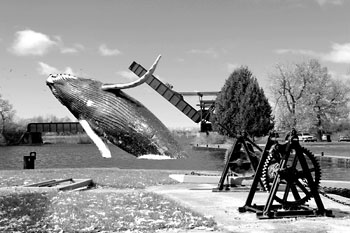There's still a large flock of geese padding about in the park today and nibbling at the snow-covered grass. Perhaps, before heading south, they're waiting until our river has frozen over.
I shall be away too, tomorrow, but not for as long as the geese. I'm coming back to Ottawa on December 12th. The rivers I'll see during my short migration are the Thames, the Seine and perhaps the Neckar.
Thursday, November 24, 2011
Wednesday, November 23, 2011
A new season starts
For the record, here is the first covering of snow in our part of town this winter, by the Rideau River, this photo taken on November 23rd. Much of the snow has melted since this morning; no doubt it will be back soon. The warm colours come from the low rays of the late afternoon sun, most welcome after a grey and white start to the day.
Friday, November 11, 2011
Another beautiful morning
I drove east along the Rockcliffe Parkway on the bluffs above the Ottawa River this morning and the view was wonderful, all the houses along the rue Jacques Cartier on the opposite bank lit up by the morning sun. The grass by the road was silvery with frost ... and so were the wing covers of our 'plane that's parked at Rockcliffe airport.
Thursday, November 10, 2011
Seeds in the wind
Not many flowers are still in bloom along the banks of the river, but the potential for next year's flowers is already there.
Dandelions are much in evidence around the time of the Ottawa Tulip Festival (in May), so much so that Kemptville in the township of North Grenville, further up the Rideau River, hosts a rival Dandelion Festival.
The pods of the milkweed plants, once empty of seeds, can serve as pretty Christmas decorations in a vase or doorway plant pot. In people's gardens, these plants are often seen as invasive nuisances, weeds that are hard to eradicate. However, the flowers of the milkweed are famous for attracting the Monarch butterflies that migrate here all the way from Mexico. I'm afraid their numbers are diminishing, so they need all the help they can get.
 |
| Dandelion seed head in November |
 |
| Dandelions by the river in May |
 |
| Milkweed seed head |
Labels:
Dandelion Festival,
milkweed,
Monarch butterflies
Wednesday, November 9, 2011
Whale at Smiths Falls?
The organisation called Friends of the Rideau publishes a newsletter three times a year, and its latest edition opens with an article about the geological history of the region, including the mention of whale bones found at Smiths Falls. The article is illustrated with an extraordinary "photo" and caption which I hope they don't mind my republishing here. Ken Watson obviously has a sense of humour.
... In 1883, gravel to be used as railway ballast was being excavated from the Welsh gravel pit, about 5 km north of Smiths Falls. Workers in the pit came across several large bones. Word of these bones came to the attention of J.W. Dawson of McGill University, a geologist who specialized in this sort of thing. He collected the bones and they were later identified as being pieces of a vertebrae and a rib of a humpback whale (Megaptera novaeangliae). Later investigators found bones of beluga whales (such as those in a gravel pit at the northern edge of the Ottawa airport), marine clams and other evidence of a moderate saltwater environment that existed in this area at the end of the last ice age.
This saltwater environment was the Champlain Sea, formed about 13,000 years ago as the glaciers continued their retreat over the depressed landscape. Waters from the Atlantic Ocean mixed with glacial melt-waters and river drainage to create a brackish sea which extended past (west and south) of Ottawa. The southern limit of this sea on the Rideau Canal was near Nobles Bay of Big Rideau Lake. And, at that time, beluga whales, and at least one humpback whale, were swimming over what is the Rideau River today. That same sea is also responsible for the deposition of the famous (or infamous) Leda clay – the unstable “quick clay” that underlies large areas near Ottawa (and some other parts of eastern Ontario)...
At the water's edge
 |
| The river's edge by daylight |
When we walk by the river in the dark, even though a full moon might be shining (that and the stars reflected in the water) we can't always see clearly what's in the shadows.
"That's not ice, is it?" said Chris the other night as we came through Bordeleau Park. Something pale, flat and thin had spread itself on the water's surface near the bank.
No, it wasn't ice (yet). It was a layer of fallen leaves.
Wednesday, November 2, 2011
A miniature river of stones
I am going to the Museum of Civilisation on the other side of the Ottawa River this morning and if I have time shall take a look outside at the Japanese "Zen Garden" ––created on a rooftop opposite the main building. This miniature landscape has a simple, peaceful look, resembling a mountain stream and its rocky banks, with pebbles representing the flow of water. (I took these photos about a month ago, so with the season's advance, the look will be different now.)
The Japanese co-designer Shunmyo Masuno has done such things in other parts of the world as well, using material found locally (here, the stones come from the Gatineau hills). You can find another picture of the Gatineau garden on his "Overseas" page (scroll down). It was designed with the theme Wakei No Niwa in mind, a reference to understanding and respect between the Japanese and Canadians. The pebbles may only be raked on ceremonial occasions by a Zen Buddhist priest. The garden was officially opened in 1995 in the presence of Prince and Princess Takamado of Japan.
Subscribe to:
Comments (Atom)




